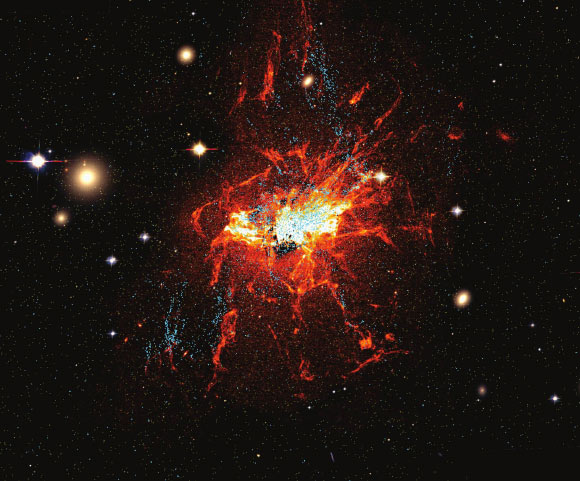Astronomers Find Thousands of Young Globular Clusters around Perseus Cluster’s Central Galaxy | Astronomy – Sci-News.com
Many thousands of compact and massive star clusters have formed at an approximately steady rate over the past one billion years around NGC 1275, the central galaxy of the Perseus cluster, according to new research published in the journal Nature Astronomy.

This Hubble image shows young globular clusters (blue) and filaments of cool gas (red) around NGC 1275 in the center of the Perseus cluster (also known as Abell 426), a group of over 1,000 galaxies located 240 million light-years from Earth. Image credit: Lim et al, doi: 10.1038/s41550-019-0909-6.
Globular clusters are spherical groups of thousands or even millions of ancient stars, gravitationally bound into a single structure about 100-200 light-years across.
These stellar systems are among the oldest known objects in the Universe and are relics of the first epochs of galaxy formation.
They are most numerous around massive elliptical galaxies and typically reside in galaxies’ outer and less-crowded areas.
“It is not fully understood why the brightest galaxies form in the center of the galaxy clusters,” said Professor Thomas Broadhurst, an astronomer at the University of Basque Country.
“The fact that they contain thousands of old globular clusters may be a point to take into consideration.”
In a new study, Professor Broadhurst and colleagues analyzed images of NGC 1275, a giant elliptical galaxy in the center of the Perseus galaxy cluster, taken with the Advanced Camera for Surveys (ACS) on the NASA/ESA Hubble Space Telescope.
“We discovered that thousands of new globular clusters have been forming over the last billion years out of a cool gas in the giant galaxy located in the center of the Perseus galaxy cluster,” Professor Broadhurst said.
“The younger globular clusters are closely associated with, and therefore formed from, a complex network of cool gas that extends to the outer reaches of the giant galaxy.”
“This network of cool gas precipitates from the hot gas that infuses the entire Perseus galaxy cluster. In fact, the gas concentrates in the center allowing it to cool faster and that leads to the creation of globular clusters.”
“Once formed, these infant globular clusters do not remain in the network of cool gas and rain inwards onto the giant galaxy like raindrops falling from the clouds.”
“So, one could expect that the central galaxies of these clusters will grow in brightness over cosmic time as a result of the rain of globular clusters they receive from the gas that surrounds them,” Professor Broadhurst said.
_____
Jeremy Lim et al. Sustained formation of progenitor globular clusters in a giant elliptical galaxy. Nature Astronomy, published online October 21, 2019; doi: 10.1038/s41550-019-0909-6





